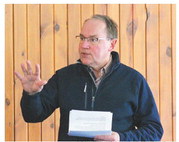Reader opposes metallic mining in Taylor County
Vox Pop
Does Taylor County need a mine? The Flambeau mine at Ladysmith continues to be held up as a “model mine.” However, the only contribution it gave to Rusk County was not economic growth, but the poison it continues to leak into a tributary of the Flambeau River for the past twenty-five years. The well-documented research of Laura Gauger, Roscoe Churchill, and Tim Tynan, which showed that the Flambeau mine didn’t lift Rusk County out of its economic slump, should have put to rest the myth that if a mine comes, economic prosperity will follow. Nevertheless, politicians and other mining interests are counting on that myth to enable GreenLight Metals [GLM] to extract gold and copper from the Bend deposit in Taylor County.
According to GLM’s website, the Bend figures into a larger plan to mine various ore deposits in the entire northern half of Wisconsin. The justification for this Canadian mining company’s audacious grab of Wisconsin’s metals is its desire to be at the forefront of capturing the critical metals market. Critical metals are in demand for green energy technology. However, copper has recently been removed from the critical metals list by the U.S. Geological Survey due to its already abundant supply, and gold is not a critical metal. While GLM may hope to reap great profits by extraction of these metals, critical or not, its proposed mine at the Bend should raise a red flag in our minds, as there is no guarantee that GLM’s promise of employment opportunities and economic growth will be kept or its mining activities will be environmentally safe.
Technological advances in the mining industry have meant that employment opportunities are increasingly more available to specialists such as geologists and mining engineers, with fewer and fewer jobs going to blue collar workers. Also, uncertainty and instability are characteristic of the international metals market. Metals prices fluctuate. The price of copper, for example, has risen and fallen in recent years. If its price should plummet during a Bend mine operation, the mine may close, and workers laid off indefinitely.
The Chequamegon-Nicolet National Forest in which the Bend deposit is located, and Taylor County’s multiple lakes and streams and lush green countryside are valued for their aesthetics, opportunity for respite, and recreational enjoyment. But they hold another value, their importance to Taylor County’s economic wellbeing. Mining the Bend deposit risks potential destruction of these natural environment amenities, and that would be perilous for Taylor County’s economy.
Thomas Michael Power, chairman of the economics department at the University of Montana, studied the impacts of mining in the American west over a 30-year period. This experience allowed him to gain an understanding of the importance of the natural environment as the base for a community’’s current and future economy. He observed that, over time, the high quality of living provided by an area’s natural environment has attracted people, businesses, and economic activity, inclining them to settle and stay, a setting that is crucial to the area’s economic development and stability. Investment relies on diversification as well as stability, qualities not found in a mine economy, but ones that are encouraged by an economy based on the natural environment. Local entrepreneurship builds economic resilience as it must actively find solutions to meet the community’s needs rather than passively relying on a large corporation for that purpose. Because a destroyed natural environment cannot foster these dynamics necessary for economic growth, it leads to an economic disaster.
A considerable body of research has been done on the economic impacts of metallic sulfide mining. The late U.W. Madison professor of rural sociology William R. Freudenburg and Lisa J. Wilson of the Watershed Research Center extensively reviewed this area of research and revealed that “the areas of the United States having the highest levels of long-term poverty, outside of those having a history of racial inequalities, tend to be found in the very places that were once thriving extractive industries - most notably in Appalachia, but to a lesser extent also in other one-time mining and logging areas such as the ‘cutover region’ of the Upper Midwest.”
Such sobering evidence as presented here begs the question: Why would the people of Taylor County opt for an uncertain, possibly catastrophic, future brought on by a mine, instead of building on the cornerstone of economic prosperity - their natural environment that is already in place? If we open our eyes to reality, believe the well-documented evidence, and weigh the substantial risks, the choice should be clear: No social license for GreenLight Metals. NO MINE!
— Juliana Reimann, Madison



